Tailor-made
Photo
Safari
Tanzania
for
Private Groups
"Welcome to Tanzania"
the Soul of Africa
First Destination In Africa For Wildlife Photography
and Most Authentic Photo Safari
Tanzania is famous in the world of wildlife photography for the photo safaris into the most important nationals parks like Serengeti, Ngorongoro Crater, Tarangire, Selous and many others.
First on the list is the leggendary Serengeti N.P. where during the migration season millions of wildebeest cross the Mara River, giving spectaular views of wildlife and the opportunity to realise amazing photos during the entire Photo Safari.
Tanzania is also the original land of the Masai tribe, a fascinating tribe dressed in strong colors and interesting ornaments, for the joy of all photographers who love portrait photography.
Suggested
PHOTO SAFARI
here you have some of our suggested Photo Safaris
but you can custom your path and decide where and how many days to spend
_
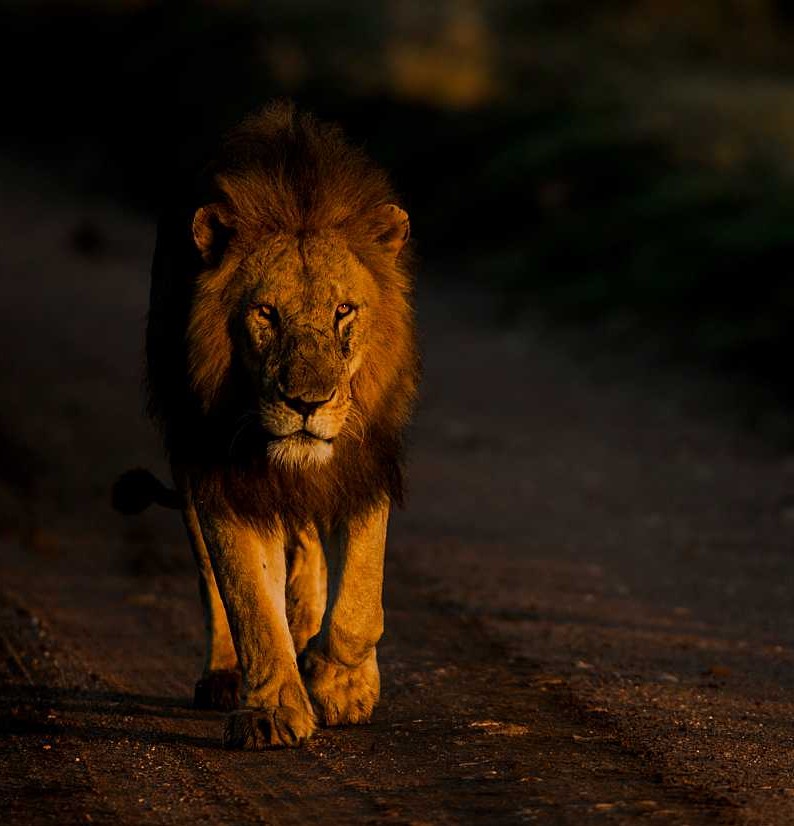
Serengeti N.P.
Ngorongoro Crater
SEASONS: December/March - June/September
DURATION: min. 7 days safari
The photo safari begins in the plains of the Serengeti National Park and ends at the Norongoro Crater. We will visit the southern area of the Serengeti where the great migration of wildebeest arrives to give birth to their puppies during the winter season.
We will follow lions and cheetahs with their cubs without losing wonderful shots of other equally important animals.
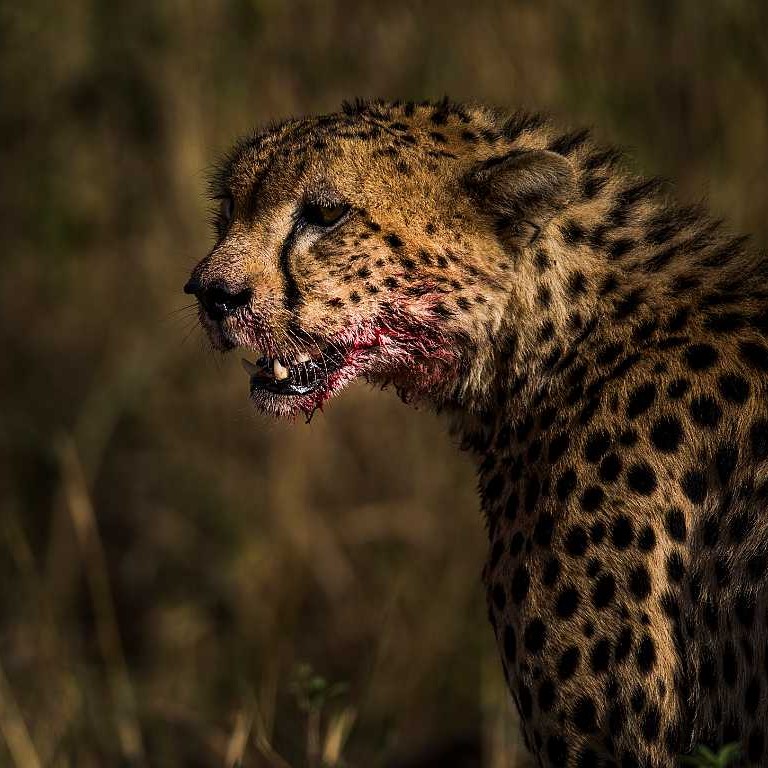
Lake Natron, Serengeti NP,
Lake Manyara NP
SEASON: July/September
DURATION: min. 10 days safari
This photo safari in Tanzania is the most itinerant among our proposals and is perhaps a one-of-a-kind photo tour. We will leave from Arusha and move towards Lake Natron to visit this amazing paradise, where we can shoot the best images of pink flamingos and of the most original Masai tribes. We continue our photo safari, driving north, into the Serengeti NP where we follow the great wildebeest migration across the Mara river. We move through this amazing National Park from north to south where we stop in a location off the beaten track for more amazing images. We end this photographic tour dedicating one more big game drive into Manyara NP. , famous for its lions on the tree branches.
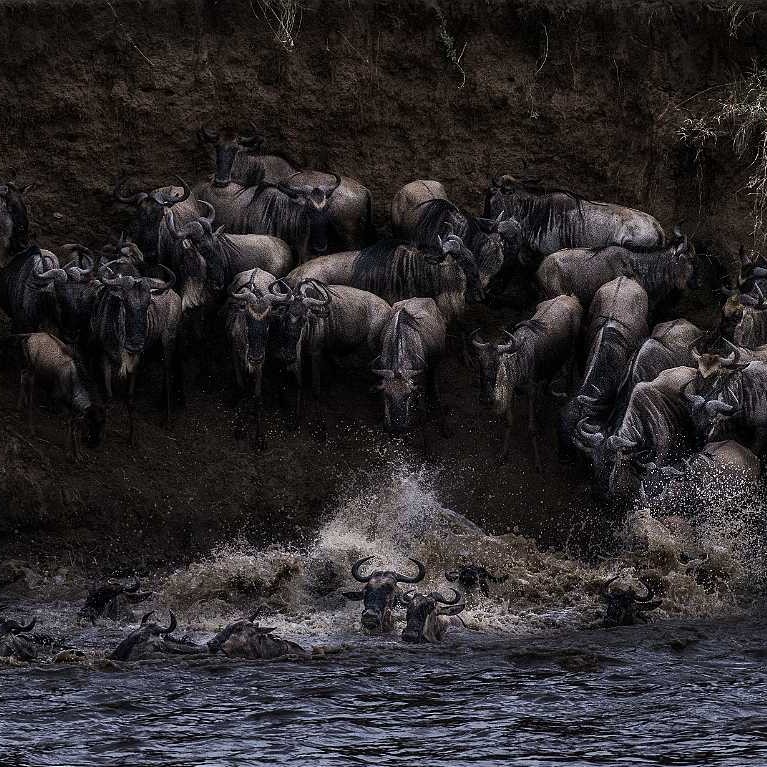
Serengeti NP
The great Migration
DATE: July/September
DURATION: min. 8 days safari
This photo safari is concentrated in the northern area of the Serengeti N.P., along the Mara river, to observe the great migration. We will dedicate all of our time here to a photographic safari based on action photography.
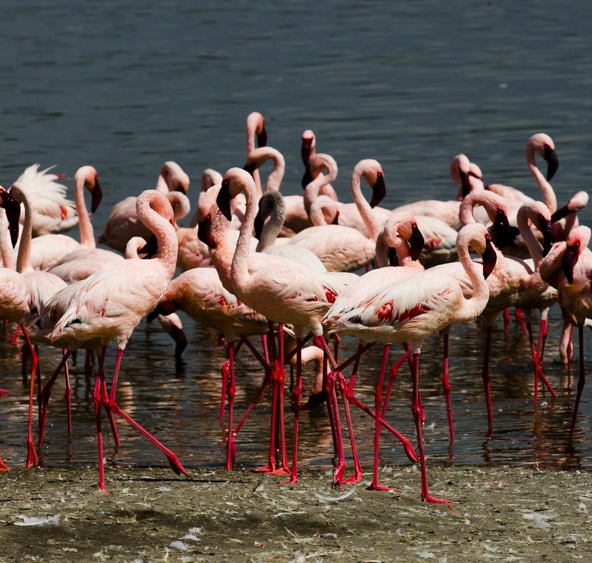
Lake Natron
Serengeti NP
DATE: June/September
DURATION: min. 8 days
On this photo safari we visit two important geographical areas: Lake Natron and the Serengeti National Park.
The itinerary is also designed to create beautiful landscape photographs in a context of incredible colors.
Lake Natron is known as the unique paradise of pink flamingos and the Serengeti National Park is now famous for the great wildebeest migration. We will focus on the northern part of the great Serengeti plain, bordering the Masai Mara in Kenya, for a game drive in the search for hunting scenes.
.
the Light moments
The first golden light of the morning and the last of the evening , we know, are the best moments to shot beautiful pictures…. Thit is the first reason why we use mobile tents during our photographic safari, rather than relying on classic Lodge or fixed tented camp..
This choice is strictly linked to the need to be in the most strategic places of each park to photograph animals and landscapes in the best light conditions that the day offers.
It must be specified that the golden light at the equator lasts not to long, so it is necessary to be on the spot before the sun rises and we must be able to stay until the last light at sunset. The use of our tented camp during photographic safari allows us to be, before dawn, in the strategic place to gather animals when they are most active. These are the moments when the best photographs of the day are taken. All other safari companies rely on classic lodges or fixed tented camps, which remain too far from the scenes and require long transfers to reach the best areas.
This means that customers arrive at the place when the best light is over and the same problem arises again in the evening where they have to return to the camp before dark, losing the moments of better light than the sunset. To be obliged to leave the scene with the best lights of a sunset during a photo-safari is one of the most frustrating things for a nature photographer. We will be able, instead, to wait until the last light fades away, before returning to our camp, which is at a short distance. For these reasons we will always be the first to reach and the last to leave the strategic points.
.
The Territory
The territory of Tanzania is extremely varied, predominantly mountainous in the northeast, where there are volcanoes Ngorongoro and the very famous Kilimanjaro, which with its peak at the height of 5.895 m, is the highest peak of the African Continent, the Pare Mountains, Mount Meru.
In the north and west lies the region of large lakes, including Lake Victoria (the largest), Lake Tanganyika (the deepest), Lake Manyara and Lake Natron, characterized by salt water, located in the Rift Valley, near the border with Kenya. To the west we find Lake Tanganyika.
To the northwest of these mountain ranges is the famous Serengeti National Park, which extends to the west of Tanganyika an houses the Savannah, a river forest and woods.
The center of Tanzania is constituted by a vast plateu with grasslands and cultivated lands. Tanzania face east on the Indian Ocean, just off the coast is the archipelago of Zanzibar with Pemba, Unguja and Mafia.
The climate of Tanzania varies as much as its morphology, inland the temperatures are mitigated by the altitude, while on the coast we find a warm and humid climate, typically tropical.
In Tanzania there are mainly two rainy seasons: the longest and most consistent is from March to May, while the less intense is between November and December.
Tanzania is the perfect place for those who love adventure, photographic safari and photography: Tanzania remains an unparalleled country, in terms of naturalistic richness, with the conservation of wildlife and flora, its parks and reserves represent a quarter of its national territory with unusual habitats and indescribable landscapes: tribes, animals and a succession of breathtaking views make Tanzania the ideal destination for a dreamy photographic journey.
Tanzania is one of the country with the largest biodiversity on the planet, offers photographic trips between mountains and sea ... we are focused on photographic-safari in the parks of Tanzania but, for mountain lovers we organize ascents on the famous kilimanjaro with professional guides and sherpas for transporting the equipment. Mount Meru is another popular destination that offers breathtaking excursions. For those who want to spend some time on the ocean, we offer trips on the Tanzanian coast, offering wild and fascinating places, or tours of the Pemba and Zanzibar Islands to enjoy paradisiacal glimpses of atolls and wonderful beaches.
On the geographic map of Africa below, we highlighted Tanzania and then we attached a magnification where the National Parks and areas of naturalistic interest are shown.
_
Safari in the Northern Tanzania Circuit
The parks of the North are the closest to our logistics base and boast the highest animal concentration.
In some ways we consider the safari In northern circuit the most desiderable from the photographic point of view. These are all the Parks in our photo-safari
- Serengeti National Park
- Ngorongoro Conservation Area
- Lake Manyara National Park
- Tarangire National Park
- Kilimanjaro National Park
- Arusha National Park
- Lake Eyasi
- Lake Natron
Serengeti National Park
We will reach the immense Savannah of the Serengeti, the most famous national park in Africa, thanks to all the documentaries turned to its internal, and we will try to this natural paradise for a photo-safari, adapting it to its rhythms, searching the more interesting scenes of action.
The Serengeti National Park is the best known wildlife sanctuary in the world, unequalled for its natural beauty and scientific value, home to the great migration of Wildebeest and Zebra and the inevitable hunting of big predator ( felines and crocodiles) during the crossing of the rivers. This ecosystem is one of the most prolific in the world and an ideal place for Safari and wildlife photography. Its includes several other game reserves and parks, notably the Ngorongoro Conservation Area and Kenya ‘s Masai Mara National Park. The great Serengeti area is roughly defined by the wildebeest migration route.
The Serengeti ecosystem is one of the oldest on earth and unique. The resident population of lion, cheetah, elephant, giraffe, and birds is also impressive. This park can be divided into 3 section.
The popular southern/central part , land of endless plains, it s savannah, dotted with acacias and filled with wildlife. The western part is marked by the Grumeti River and has more forests and dense bush. The north, lobo area, meets up with Kenya’s Masai Mara Reserve.
RAIN SEASON (from November to May)
We will visit the central and south area of Serengeti, where, as into Ngorongoro, the animals are concentrated in the rainy season: here, between December to March, the herbivores live and reproduce between vast expances of low grasse, thanks to an ideal soil for the amount of minerals and nutrients, essential for the growth of puppies during the first months of life.
Mothers with their puppies offer us spectacular images to watch and are important photographic opportunities that we are going to immortalize with the very first light of dawn and the last flashes at sunset.
DRY SEASON (from June to October)
We will follow the herbivores that during the dry season migrate from the north, on the border with the Masai Mara, heading south, creating scenarios of extreme charm that we will capture in the best light conditions at sunrise and susnset.
Thanks to our experience in Safari and the knowledge of the territory, we will reach the most remote areas of the park and we will enter in beautiful places, far from the usual paths beaten by mass tourism, to find unique and unmissable photographic opportunities, in a real paradise of wildlife.
Thanks to special permits we will be able to follow the felines out of the normally authorized trails, positioning ourselves in the best spots according to our photographic needs to capture the most authentic scenes.
Leaving from the field at dawn, when it is still dark, we will look for predators to catch them at first lights.
During our Photo-Safari we love spending the day following the big felines….sometimes breaking the day with some re-entry to the camp, not far away, for a pause, a good meal and a comparison on the pictures just made.
If we are lucky enough to find us in interesting situations like in front of a family of lions or cheetahs with their puppies, we will be glad to wait, even for the whole afternoon, in the shade under an acacia, without losing sight of them, waiting for them to come back into action in evening hours, so managing to create beautiful photographs with the sunset lights.
In addition to animal photography, a photo safari in the Serengeti is an unmissable opportunity to take pictures of the enchanted views. The golden grassy savannah during the dry season and intense green during the rainy season, make the Serengeti a fascinating place for landscape photography.
It is usual to meet lions or cheetahs sheltering from the sun and laying down into the shade of the acacias during the hours of the day, however careful to what happens around.
This Safari does not required man movements and will allow us to enjoy the photography with the comfort of the tended camp near the best scenes.
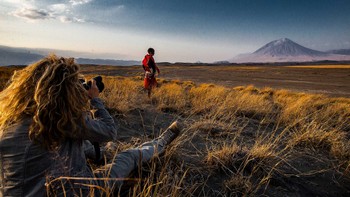
Lake Natron
Lake Natron, the Red lake with vortexes, is a place as of incredible charm as lethal and ideal destination for a photographic trip.
At Natron you can create photographs of extraordinary beauty by exploiting the contrast of shades of colors, ranging from pink to carmine red to orange, with white streaks, due to sodium accumulation, that create veins in the shape of a vortex, and the pink flamingos that inhabit it and the Gelai volcano that acts as a sprawl. It is an area completely unrelated to mass tourism. On its banks was shot the fabulous documentary made by Disney nature entitled “the mistery of pink Flamingos”.
The Masai tribes, living at its borders, are the most fascinating and authentic in absolute and will offer countless photographic opportunities. The Natron is a lake rich in salts and carbonates and owes its composition to the alkaline magmatic rocks emitted by the volcano. The minerals end up in the lake through the natural path of rainwater.
On the shores of the lake there are carcasses of naturally stuffed animals, thanks to the particular composition of its water; a book by the photographer Nick Brandt has also been created that has immortalized the embalmed animals by posing them and crating beautiful photographs. The water compound contains sodium hydrate carbonate and is lethal to most of what live, except for Flamingos which are the only species immune to the natron. Here thousand of Flamingos find their ideal environment to lay eggs; lake Natron is therefore an unmissable stop for lovers of photography which offers multiple ideas to make magnificent photos.
Ngorongoro – Natural reserve
The crater of Ngorongoro is a large volcanic caldera that offers a landscape of extraordinary beauty for an incomparable Safari: a huge crater that contains within it an impressive number of animals, as herbivores attracted by the soil rich in minerals, and consequently predators.
The crater is the ideal place for a photographic Safari where you can meet the so-called “Big Five”: Lion, Leopard, Elephant, Buffalo and some specimens of rhinoceros, which unfortunately is almost extinct and don’t exist in any other parks of Tanzania.
During the Safari we will explore this huge crater, which cover an area of 265 square kilometers, visiting the different areas, paying particular attention to the shadows created by the crater ring: we will photograph animals in some places during the dawn and in other at sunstet with the aim of obtaining the best photographic result.
Moreover, the Masai tribes, that live in Ngorongoro, offer one more opportunity for wonderful photographs, while the Pink Flamingos, that reflect in the shallow waters of the Magadi lake at the bottom of the crater, are an unmissable shows to photograph at dawn.
Arusha – National Park
The Arusha National Park is the smallest and least known among the parks of northern Tanzania but one of the most beautiful under the photographic profile. Inside the park rises Mount Meru with an altitude of 4566m and its volcano still active, while its small lakes Momella offer enchanting landscapes to photograph.
From the ring of Ngurdoto Crater you can enjoy a spectacular view of the lakes and Kilimanjaro to photograph.
The National Park of Arusha hosts the largest concentration of Giraffes in the world and is therefore the ideal park for photographing these elegant animals in a context of particular backgrounds. In Arusha National Park is possible take pictures of many species of antelopes, African buffaloes, warthogs, hyenas and thousand of flamingos living in the waters of Momella lakes.
The Tarangire National Park is a very interesting destination from the photographer point of view: it is an area of rare beauty characterized by a succession of rolling hills, beautiful to be seen in the dry season but wonderful when they are green.
This park proves to be very fascinating for a photographic safari because, in addiction to its beautiful landscape, it is the second park in Tanzania for its great concentration of wildlife.
To all intents and purposes it is the undisputed kingdom of elephants and gigantic Baobab, which are the constant background to the wild natural landscape. The areas around the Silale swamps, instead, are particulary suitable for pictures of animals portrayed with panoramic backgrounds. The park also offers much of bird lovers for the many springs that live there, including the Russian steppe eagle.
During June to October we concentrate mostly along the Tarangire river, where the animals are more present, as they find water even during the dry season.
The Manyara Lake, at the foot of the Rift Valley, is al Lake of alkaline water in apark of rare beauty where relize a beauty photo-safari. The park distinguishes itself from others for its very varied vegetation, in fact it hosts a forest, a savannah and lake vegetation, offering different photographic prospective in a small area. The top view of the Rift Valley offers breathtaking photographic views. Tha Manyara park is inhabited by many animal species as well as considered a true paradise for bird photography lovers.
Moreover you can make unusual photographs of lions because, contrary to what happens in other parks, here they have the habit of climbing trees. The park is also known for its large flocks of pink flamingos that give beautiful photographs and give the lake a color with particular nuances.
_
PLAN THE TRIP TO TANZANIA
Depending on the time you have available it will be possible to plan and optimize your photo safari in Tanzania:
ONE WEEK
If you have only one week available, you can opt for a photo-safari in the parks of the North.
The arrival airport is the Kilimanjaro International Airport, here we will come to pick up you and start our adventure.
If you prefer to opt for a Safari in the circuit of the parks of the south, the arrival airport will be Dar Er Salaam and from this airport will begin our journey.
TWO WEEKS
Two weeks are a good time to realize a wonderful travel in Tanzania. We can offer you a Safari full immersion by touching two different areas: the parks of north and spend the week after relaxing on the beautiful beaches of the African coast or Zanzibar.
A MONTH
With a month available you will have no trouble to visit Tanzania, this wonderful glimpse of Africa, passing from a Safari to a trekking to a dream sea extension.
COST
We can suggest the best route to adapt the services and the costs to your budjet and to the time at your disposal. Contact us, we will find together the right solution to your request.
We will be happy to interact with you to find the best solution and get an exciting travel program.

